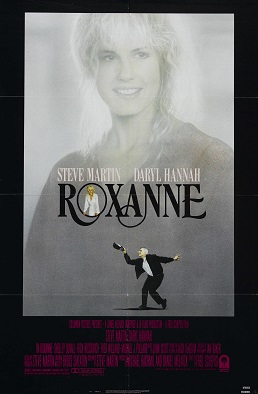
Roxanne is a 1987 American romantic comedy film directed by Fred Schepisi and starring Steve Martin and Daryl Hannah. It is a modern retelling of Edmond Rostand's 1897 verse play Cyrano de Bergerac, adapted by Steve Martin. Rostand is mentioned in the opening credits.
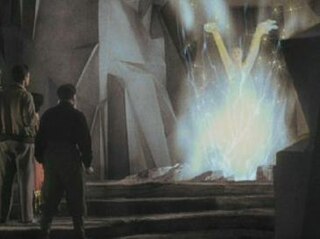
Film colorization is any process that adds color to black-and-white, sepia, or other monochrome moving-picture images. It may be done as a special effect, to "modernize" black-and-white films, or to restore color films. The first examples date from the early 20th century, but colorization has become common with the advent of digital image processing.
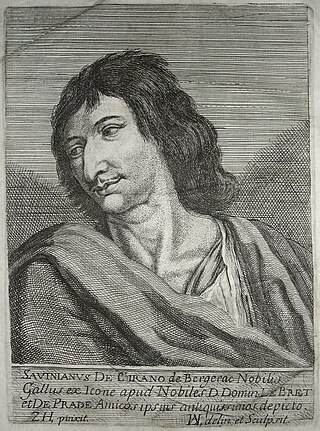
Cyrano de Bergerac is a play written in 1897 by Edmond Rostand. The play is a fictionalisation following the broad outlines of Cyrano de Bergerac's life.

Cyrano de Bergerac is a 1990 French period comedy-drama film directed by Jean-Paul Rappeneau and based on the 1897 play of the same name by Edmond Rostand, adapted by Jean-Claude Carrière and Rappeneau. It stars Gérard Depardieu, Anne Brochet and Vincent Perez. The film was a co-production between companies in France and Hungary.
The Handschiegl color process produced motion picture film prints with color artificially added to selected areas of the image. Aniline dyes were applied to a black-and-white print using gelatin imbibition matrices.
Film tinting is the process of adding color to black-and-white film, usually by means of soaking the film in dye and staining the film emulsion. The effect is that all of the light shining through is filtered, so that what would be white light becomes light of some color.
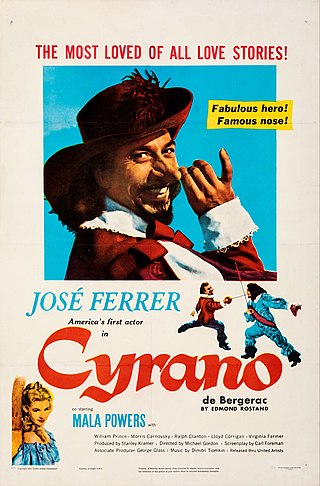
Cyrano de Bergerac is a 1950 American adventure comedy film based on the 1897 French Alexandrin verse drama Cyrano de Bergerac by Edmond Rostand. It uses poet Brian Hooker's 1923 English blank verse translation as the basis for its screenplay. The film was the first motion picture version in English of Rostand's play, though there were several earlier adaptations in different languages.

Color motion picture film refers both to unexposed color photographic film in a format suitable for use in a motion picture camera, and to finished motion picture film, ready for use in a projector, which bears images in color.

Augusto Genina was an Italian film pioneer. He was a movie producer and director.

Carmine Gallone was an early Italian film director, screenwriter, and film producer, who was also controversial for his works of pro-Fascist propaganda and historical revisionism. Considered one of Italian cinema's leading early directors, he directed over 120 films in his fifty-year career between 1913 and 1963.
Pathécolor, later renamed Pathéchrome, was an early mechanical stencil-based film tinting process for movies developed by Segundo de Chomón for Pathé in the early 20th century. Among the last feature films to use this process were the British revue film Elstree Calling (1930) and the Mexican film Robinson Crusoe (1954) by Spanish Surrealist Luis Buñuel. The Pathécolor stencil process should not be confused with the later Pathécolor, Pathé Color and Color by Pathé trade names seen in screen credits and advertising materials. Like Metrocolor, WarnerColor and Color by DeLuxe, these were simply rebrandings, for advertising purposes, of the use of Eastman Kodak's Eastmancolor color negative film for the original photography.
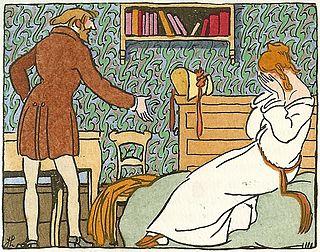
Joseph Hémard, a popular French book illustrator, was born in Les Mureaux, France, a small town on the Seine, northwest of Paris, on 2 August 1880. He died on 9 August 1961 in Paris. He was a prolific artist. During the early years of the 20th century he published cartoons and comics in illustrated newspapers like Le Pêle-mêle or Le Bon Vivant. He also designed costumes and sets for several operas, patterns for printed textiles, bookbindings, posters and even a facade for a bar in the 1925 Paris Exposition of Decorative Art. His lasting fame, however, lies in his book illustrations – always distinctly French in character and often erotic – which he produced for a great number of titles including many classics of French literature such as Le Malade Imaginaire (1920), Gargantua et Pantagruel (1922), Jacques Le Fataliste (1923), Cyrano de Bergerac (1927), and Aucassin et Nicolette (1936).
Pierre Frédéric Magnier was a French actor who began on the stage in the 1890s and became a prominent silent film actor in France. He was the second actor to portray Cyrano de Bergerac in any film in 1925. He continued acting until the 1950s. He is most remembered for the role of the General in Jean Renoir's La règle du jeu, where he has one of the films more poignant quotes when he praises Marcel Dalio's character as one of "a vanishing breed."
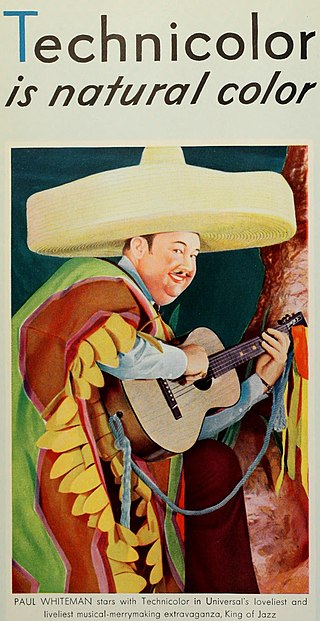
Technicolor is a series of color motion picture processes, the first version dating back to 1916, and followed by improved versions over several decades.

Giuseppa Iolanda Menichelli, known professionally as Pina Menichelli, was an Italian actress. After a career in theatre and a series of small film roles, Menichelli was launched as a film star when Giovanni Pastrone gave her the lead role in The Fire (1916). Over the next nine years, Menichelli made a series of films, often trading on her image as a diva and on her passionate, decadent eroticism. Menichelli became a global star, and one of the most appreciated actresses in Italian cinema, before her retirement in 1924, aged 34.

Cyrano and d'Artagnan is a 1964 French adventure film directed by Abel Gance, starring José Ferrer and Jean-Pierre Cassel. It is set in 1642 and tells the story of how the poet and duelist Cyrano de Bergerac teams up with the musketeer d'Artagnan in order to stop a plot against king Louis XIII. The film draws from Edmond Rostand's 1897 play Cyrano de Bergerac and Alexandre Dumas' three-volume novel d'Artagnan Romances. Ferrer repeated his role from the 1950 film Cyrano de Bergerac. Cyrano and d'Artagnan had 651,213 admissions in France.

Cyrano is a 2021 romantic drama musical film directed by Joe Wright and with a screenplay by Erica Schmidt, based on Schmidt's 2018 stage musical of the same name, itself based on the 1897 Edmond Rostand play Cyrano de Bergerac. The film stars Peter Dinklage, Haley Bennett, Kelvin Harrison Jr., and Ben Mendelsohn.

Alex Bernard was a French silent film actor.















